#Japan imperial fami
Text
chapter 140 thoughts under the cut

fujimoto's goal of rewriting fire punch with a bit more silliness continues (i love the chainsaw pews)
fujimoto said i know writers who do subtlety and they're all cowards
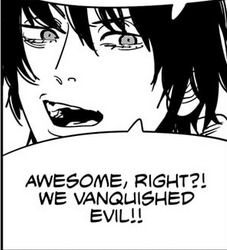
BROBENI CONFIRMED. now to know if he's her younger brother who was gonna be put through college by kobeni's exploited labour (which..... gd damn that parallel with denji and nayuta......). also i've been told nobana is traditionally a female name.......... hm.
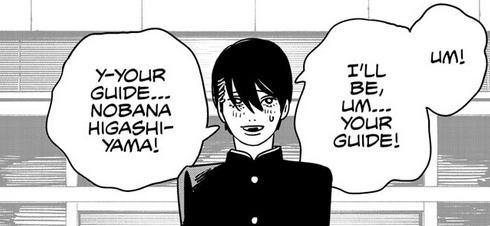
real, though in this context it sounds more like anti usamerican imperialism language repurposed for nationalist ends..... it's not fujimoto is uncritical of america either though considering the gun devil in part 1. fascinating to see where this might go and how much that kind of language parallels irl pro-japanese imperialism and nationalists' own discourse.
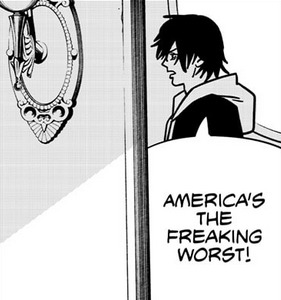
i find it fascinaing that kids are considered the only acceptable members of the cult only to be introduced to an adult leader several pages later lol. but obviously the cult (because this 200% is a cult) is filling a gap--the first half of part 1 showed us how much it fucking SUCKS to be even an ordinary kid both irl and in this world, the lack of agency and the poverty and being preyed upon by adults or abandoned entirely, and then mocked on national tv when they take the deaths of their classmates and friends seriously..... so of course so many would end up here, being told that adults really ARE dangerous and incapable of seeing the world the way they do. cleverly done, i hope fujimoto expands on this and doesn't fall back on Let Adults Take Care Of This
similarly i hope this doesn't fall into the liberal storytelling trap of "the government is bad, but this new group has appeared that's Even Worse, so the government is actually good now" that also appears in so many shounen tbh. i don't think he will bc even outside of the church public safety is still so fucked up
denji's expressions this chapter are top tier lmao. genius move to make denji the "straight man" in the previous few chapters where he's genuinely flabbergasted by how batshit everyone else is
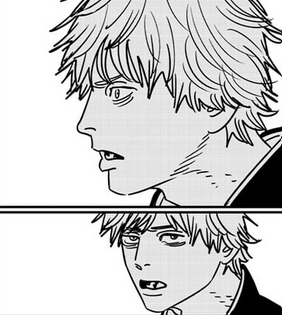
FUCKING CRYING. yeah the implications are dire but. HOWL

again jokes asides there is SO MUCH to unpack here. you'll get married AND THEN become a member of the church (implying marriage is a requirement or, as said later, strongly encouraged to join the cult at all). sex is consummated immediately in the next room. so far we've mostly seen men and boys in charge of the church, except for fami/kiga......... which...... does not bode well. makes me wonder how many are pressured into marriage/sex both as a way to attract new male followers and as a way to keep control over all
speaking of which. it says student but they mean /high school students/, maybe even middle school students, aka again children! and again the language of Modernity Has Lied To Us, Child Marriage And Ownership Is The Way right there being recited. the appeal to nationalism and what is "natural", kids as property of their parents and the church,.... and yes i AM reminded of behemboth(?), the patriarchal city-cult of fire punch whose entire horrid existence is justified with "it's natural" and "we are saving people by giving them shelter here". the patriarchy is central here!


and of course the part about kids being born and raised into the church themselves...... after shinzo abe's death, japan's having a bit of a reckoning re the influence of cults in political life and vice versa, and particularly the impact on children raised in said cults. there's also been a reactionary backlash to the idea of *foreign* cults (like the unification church, originally from korea) having "too big" an influence on japan, versus the Good National Japanese Cults that are spared some of that backlash. so i find it interesting that fujimoto firmly grounds this as a *japanese* nationalist cult that claims to be trying to save the country from foreign influence. obviously i'd love to know more, bc i'm sure there's a lot of language and references in the original that i'm missing and that mirror irl japanese politics and reactionary tendencies.
denji's backlash in forcing kids to get married.... i do wonder how much of his backlash comes from the idea of forced child marriage (and being forced in general), or if he would have been okay with someone being pressured to have sex with him without marriage, or he wouldn't have thought about it tbh.
i want to see the chainsaw man bathroom............
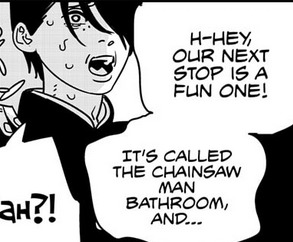
the hybrids all coming together.... wonder if this means reze and quanxi will be back PLEASE PLEASE PLEASE. but also in the context of the church.... the weapon hybrids were used as various governmental projects and living weapons for years--japan, china, the ussr, and i imagine the usa and other western powers had their own as well. then they got controlled by makima, and now they're in the church.... i hope we explore more of the abuse and parallels they have with denji, and see just how and why miri trusts in the church so much as a refuge compared to his previous abuse. ALSO BRING BACK REZE AND QUANXI GD PLEASE......
this is 200% the guy who was in the shadows telling haruka it was all planned. and again the irony of nobana talking about how this is a church by and for children, only to immediately be threatened by someone who is very obviously an adult in charge

his eyes REALLY freak me out btw, fujimoto did a great job at his expressions lol. also really love the detail of the suspenders and the
barem.... the closest i could find for that name's meaning was the hebrew for "son of nation" which. hm! worrisome!
so idk if fujimoto was TRYING to give this dude the vibes of a sexual predator but between the cult's pressuring kids to get married and have sex, his role as one of the sole adult "humans" around, his treatment of nobana, and his general demeanor and manner of speech + the themes of sexual abuse and predation in the series in general........ gd he gives me the absolute creeps lmao, incredible design and tone. also what he says here about asa which gives me SO MANY red flags and makes me think more of the patriarchal aspect of the cult too
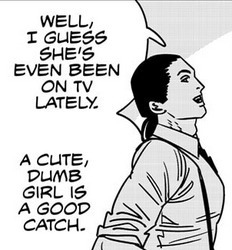
the name of the chapter is "scales"..... which is associated with kiga, as the horseman of Famine. and of course during the whole chapter we hear about how the church is necessary and its actions help save lives etc etc etc. just as we heard the yakuza justify their existence to makima, just as public safety justified its own existence in terms of killing devils while really using them as a way to terrorize the population and threaten other nations.
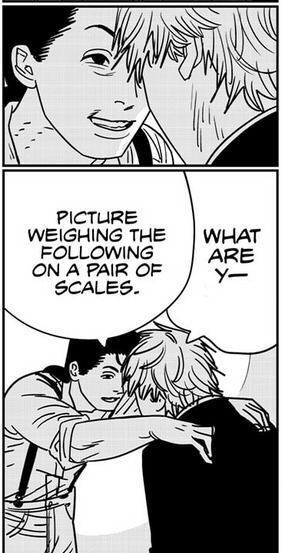
i find it interesting that in a way, kiga gave a similar deal to asa but in far more positive a view. do these things for us, become this weapon for us, and this person you care about (or think you know even if briefly) will live. kiga was just a lot better at presenting it and obsfucating the actual horrors that would follow--denji however is in too deep, and doesn't buy into the bs anymore. so he's given much more stark and open a choice! just as public safety tried to threaten denji to keep quiet lest they kill nayuta and raise her as their own all over again! gd he and asa's lack of agency..... fuck me up so so bad
wondering if we're eventually going to come back to denji's motif of choosing a third choice and refusing the dual choice entirely! wonder if asa herself will only see a single solution in front of her every time......
anyhow. good chapter. there's gotta be a lot that i'm missing here in terms of relations to current japanese political context and i'd love to learn more on it tbh.
119 notes
·
View notes
Text
Living History: Ushering in the New Imperial Era in Japan
The sunlight often peeked by means of the clouds around a sea of cameras and Japanese flags and shone on the group packed arm to arm. We waited in anticipation as safety combed the grounds and ushered us behind limitations on the outer grounds of the Imperial Palace. In this article, around 250 meters from Nijubashi Gate, was the closest the general public could arrive to witnessing the regalia inheritance, a ceremony that transpired within just the sanctity of the palace partitions attended by a couple hundred Japanese and foreign diplomatic elite. However I was not the only American, I was a person of the couple out on the imperial grounds to witness the ascension of Japan’s Emperor Naruhito.
Naruhito’s motor vehicle, a substantial and regal Toyota with silver trim bearing a tiny red flag adorned with a yellow Chrysanthemum around the headlights, steadily crossed the famed Nijubashi Bridge, as it left the interior confines of the Imperial Palace. The vehicle proceeded little by little, escorted by law enforcement cars and motorcycles. The faint determine of the new emperor lifted a hand and waved to the community. The crowd waved back again with small flags that rattled in the wind. The second was anticlimactic, absent of loud chants, shouts, or a flashy vehicle, even as the Reiwa era officially commenced on May 1.
The limo of Emperor Naruhito leaves the Imperial Palace following the regalia inheritance on May possibly 1, 2019. The procession marked the to start with time Emperor Naruhito remaining the Imperial Palace because his formal ascension to the throne previously in the working day. Photo by Spencer Cohen.
Savoring this short article? Click on listed here to subscribe for comprehensive obtain. Just $5 a thirty day period.
Through my time as a scholar at the University of Tokyo, I have leaped at the chance to participate in traditionally significant moments. Hundreds of Japanese citizens flooded the imperial grounds on the times of abdication, regalia inheritance, and very first community look to witness the historic instant of transition. Like his father Akihito, Japanese society has nearly unanimously welcomed the latest emperor Naruhito’s approval ranking attained 83 per cent in the times pursuing his ascension, and 140,000 attended the emperor’s 1st community appearance on Might 4.
Contrary to the past transition in 1989, which followed the demise of Emperor Hirohito and was marked by mourning and grief, the modern changeover was the result of abdication and has therefore been exceptionally celebratory, buoyed by the abnormal 10-working day holiday granted to many Japanese personnel. Naruhito, the to start with emperor to have studied abroad and been born in the submit-war period, embodies the continuation of the genial component to the symbol that started with his father.
“The new emperor is nearer to the people today,” noted a middle-aged guy from Nagoya.
A gentleman changes from a shirt with the people for Heisei, the era that ended with the abdication of Akihito, to one with the characters for Reiwa, the new period, on the grounds of the Imperial Palace on April 30, 2019. Image by Spencer Cohen.
Japanese aid of their generations-previous imperial tradition is an exception in a country exactly where displays of nationalism are rarely viewed and normally negatively perceived. Assistance is not to be mistaken for ecstatic nationalism, but relatively personifies a wide, ambiguous acceptance of the imperial system. As an undergraduate university student at Waseda University in Tokyo observed, acceptance of the system emanates from a belief that “there are no destructive consequences or impacts on our society” as a consequence of the emperor system.
Nationalism is normally associated with the uyoku dantai, Japan’s hyper-conservative, militaristic far-suitable. Their shows from time to time subdued, but often brash and invasive, are most typically encountered with their gaisensha, or “sound trucks,” adorned with nationalist symbols like the rising sun flag. They desire a return to pre-war and wartime Japan and critique a contemporary modern society they see as formed on the premise of American post-war neutering. The groups have also co-opted the chrysanthemum, the seal of the emperor — the symbol adorns not only the car or truck of the emperor but also the trucks of uyoku.
The concept that the imperial lineage of the Japanese monarchy is a unified and unbroken establishment for thousands of a long time is a fantasy. The process in its condition today is an “invented tradition” of the late 19th century when Japan expert a period of rigorous modernization and essential a modern day national identification to cement its new comprehension by the slogan “civilization and enlightenment.” National id turned interconnected with the emperor, as culture waged war in his name. For generations immediately after Japan’s present day development in the late 19th century, nationalism – especially in its excessive incarnations – was affiliated with devotion to the emperor.
A group holding Japanese flags on the grounds of the Imperial Palace as Emperor Naruhito and other users of the imperial family make their 1st community visual appearance right after the transition on Might 4, 2019. Picture by Spencer Cohen.
The imperial procedure survived the American scalpel wielded by Typical Douglas MacArthur, supreme Allied commander of the American profession, and taken to Japanese modern society adhering to their defeat in Globe War II. The messy incision immediately after the war tried to take out features of modern society that Allied forces deemed as the resource of imperial expansion and war, which include demilitarization of the Imperial Army and Navy and the finish of the connection concerning condition and Shinto. The emperor stood at the center of the Shinto religion as divine chief.
Rather than punishing the emperor for his wartime purpose, MacArthur favored changing the imperial apparatus into a signifies of making sure article-war continuity and national unity in obedience to the American occupation forces. Profession forces stripped the emperor of power, but the technique continued to have enormous symbolic import.
The symbol of the emperor continued to produce an unrelentingly favourable graphic right after 1989 beneath the reign of the Heisei Emperor, Akihito. Akihito, in statements and acts of remorse for the war, effectively remodeled the institution from one particular of questionable war guilt to a source of peace and post-war steadiness. “When I was youthful, I did not assume we needed an emperor,” pointed out an aged guy in his 70s in Tokyo. But “the Heisei emperor was advertising peace, which was distinctive from the authorities and the ideal wing,” which altered the man’s mind-set towards the imperial program.
Even so, as Naruhito requires the throne, a tiny strand of ambivalence, even criticism, pervades Japanese modern society. “It’s as well much, it’s as well much, I imagine,” expressed an place of work employee in his early 30s in response to the celebrations all through the changeover. The Mainichi, 1 of Japan’s primary newspapers, echoed the ambivalence in an editorial, pondering about the potential relationship in between the emperor and the persons. The piece concludes by noting, “The picture of the emperor as a symbol for the new period must be built based on the will of the public, via cooperation involving the new emperor and the Japanese individuals.”
Naruhito would seem to hear their get in touch with. On his first handle as emperor, Naruhito stated: “I will act in accordance to the Structure and fulfill my accountability as the symbol of the Point out and of the unity of the people of Japan, though constantly turning my views to the persons and standing with them.”
Flanked by a group, a reporter stands amongst can take at the Imperial Palace prior to the appearance of Emperor Naruhito adhering to the regalia inheritance on Could 1, 2019. Picture by Spencer Cohen.
Spencer Cohen is a graduate university student at the College of Tokyo and a recent graduate of Columbia University in historical past. He is at the moment enterprise visible and composed ethnographic do the job into an American foundation community outdoors of Tokyo.
The post Living History: Ushering in the New Imperial Era in Japan appeared first on Defence Online.
from WordPress https://defenceonline.com/2019/05/14/living-history-ushering-in-the-new-imperial-era-in-japan/
0 notes